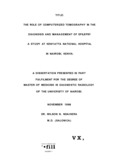The role of computerized tomography in the diagnosis and management of epilepsy: a study at Kenyatta National Hospital in Nairobi, Kenya

View/
Date
1996-11Author
Ndaihera, Wilson N
Type
ThesisLanguage
enMetadata
Show full item recordAbstract
Epilepsy is a common neurological disorder in Kenya, affecting
many people especially those below the age of 20 years. The
highest number of cases are concentrated below 10 years of
age. other age groups are also affected but to a lesser
degree. All epileptic patients who underwent comput:erized
tomography examinations of the brain at Kenyatta National
Hospital for convulsive disorders since the installation of
the Tomoscan CXQ machine on 11th November 1992 up to 31st July
1996 were retrospectively reviewed. A total of 484 patients
were included in the study.
computerized tomography (C1) was4found to be of extreme value
in screening and evaluation of seizure patients. In this
study 56.4% of the total number of patients were found to have
abnormal CT scan findings. CT scan examination is a quick,
simple, non invasive method of evaluating patients with
intracrania.l abnormalities. The diagnostic accuracy of CT
scan examination i~ high. The commonest abnormal or positive
finding was brain atrophy. Diffuse brain atrophy was more
common than focal brain atrophy.
Intracranial tumours were the second commonest abnormal CT
scan fhiding. These were all primary brain tumours.
The predominant type of brain tumours found in the study were
gliomas with (55.3%). The main seizure pattern in these
tumours was the generalized convulsive type.
The third commonest abnormal CT scan finding were cases of
infections. Brain abscesses were the commonest abnormal CT
scan finding among cases of infections, with a total of 58.6%.
Trauma cases were fourth in CT scan abnormal findings.
The role of CT scan in the dignosis of head injury patients
presenting wi th convulsions is remarkable. This mode of
investigation has virtually replaced cerebral angiography ..
since no false negative or false positive results have been
observed.
other important abnormal CT scan findings were cases of
hydrocephalus. Communicating type of hydrocephalus had the
highest abnormal, findings in this group. Cases of
hydrocephalus and cerebral infarcts occupied the 5th position
of the CT scan abnormal findings.
Patients with a short duration of seizures (less than 6
months) had the highest CT scan abnormal findings. Patients
above 65 years of age also had a high number of abnormal CT
scan findings.
The above findings correlated well with findings in other
studies, except in the age group below 10 years as described
in the text.
Citation
Master of Medicine in Diagnostic Radiology of the University of Nairobi, 1996Publisher
University of Nairobi, School of Medicine
